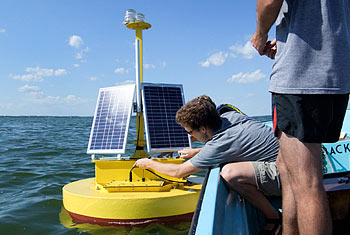Global grassroots lake science network has roots in Wisconsin
Inspired and led by freshwater scientists at the University of Wisconsin–Madison, researchers eager to understand global ecosystems from end to end are now monitoring a series of buoys in lakes on every continent except Africa. Each buoy carries instruments to measure fundamental data on the weather above the water and the temperature and chemistry below it.

Luke Winslow (left), a UW–Madison graduate student in limnology, puts final touches on a Global Lake Ecological Observatory Network (GLEON) buoy being placed in Lake Mendota on July 9, 2010. Using electricity from its solar panels, the buoy will record conditions from the surface to the lake bottom once an hour.
Photo: David J. Tenenbaum
The buoys are linked through GLEON — the Global Lake Ecological Observatory Network — but the motivation is mainly local, says UW–Madison limnologist Timothy Kratz, who chairs the network’s advisory board.
The network represents a grassroots approach to large-scale science, says Kratz. “We have these large, top-down initiatives, where all the instruments are as similar as possible, but this network is very much bottom-up. Each site already has its own local reasons for getting measurements. Banding together in the network makes the process more efficient, so we don’t repeat each other’s mistakes.”
Lakes support fishing, swimming and boating, and are an economic foundation in many resort areas, including northern Wisconsin. But increased human usage is harming many lakes, and better data on conditions is an essential part of effective lake management.
GLEON has its roots in a dissertation by Paul Hanson, who’s now an associate research professor in the UW–Madison Center for Limnology. For his research, Hanson set out buoys in 25 lakes in northern Wisconsin to measure two fundamental processes: how much carbon was being converted into organic matter through photosynthesis, and how much carbon the plants, animals and microbes were oxidizing to provide energy.
This balance “is an important indication of whether lakes are storing or releasing carbon,” says Hanson, and therefore a key component of climate studies.
More recently, data from 23 GLEON buoys was used to explore the same topic on a global scale, says Kratz. “Using measurements of dissolved gases, we can see how much carbon the algae took up, and how much respiration was going on. These are fundamental processes in lakes, an indication of how much biological activity is going on, and they tell us how much energy is available to go into higher trophic levels.”
Since its start in 2005, the network has acquired almost 200 individual members at 24 sites in North and South America, Europe, Asia, Australia and New Zealand, Kratz says. The seventh Wisconsin buoy, placed in Lake Mendota on July 9, lowers a package of instruments to the bottom every hour and records conditions at one-meter intervals. Among other purposes, the buoy will be used to explore the increasing blooms of toxic blue-green algae.
GLEON is a loose network, say Kratz, who directs UW–Madison’s Trout Lake Research Station in Boulder Junction, Wis. “We are an open, collaborative group of people, and by joining, you signify that you are also an open, collaborative person who likes to share data as much as possible.”
Handling data was a key motivation for forming GLEON, says Hanson, who heads the network’s steering committee under a Research Coordination Network grant from the National Science Foundation. “We discovered that people all over the world had similar interests in primary productivity and respiration, and had begun investing in similar technology. But these sensor networks generate a vast amount of information, and ecologists were not trained to deal with that quantity.”
The flood of incoming data requires new techniques for information management and analysis, but it also enables a different kind of science, Hanson adds. “We are scaling up from science done on individual lakes, to science done on a much bigger geographic extent.”
GLEON is also being used to explore how lakes respond to storms, Kratz adds. “Lakes come in all shapes and sizes, are situated in all kind of climates, so you’d expect any two lakes to respond to the same weather event differently.” Wind, especially on shallow lakes, can stir up sediment that feeds damaging algal blooms. “By studying a large number of lakes, we can learn to predict how a lake will respond based on shape, climate, location and depth.”
These questions become more critical as global warming feeds more storms, Kratz adds. “We are expecting a higher frequency of rare climate events, but what will enhanced wind mean for a particular lake, and how will the mixing affect its biology? These are the kind of things that the network is good at.”




